BREWING UP BATCH OF POTTING SOIL
Prime Ingredients for Any Potting Mix
Many years, my gardening season begins on my garage floor. That’s where I mix the potting soil that will nourish seedlings for the upcoming season’s garden and replace worn out soil around the roots of houseplants. Why do I make potting soil? Why does one bake bread?
There is no magic to making potting soil. When I first began gardening, I combed through book after book for direction, and ended up with a mind-boggling number of recipes. The air cleared when I realized what was needed in a potting soil, and what ingredients could fulfill these needs. A good potting soil needs to be able to hold plants up, to drain well but also be able to hold water, and to be able to feed plants. The key ingredients in my potting mix are: garden soil for fertility and bulk; perlite for drainage; and a mix of peat moss and compost for water retention.
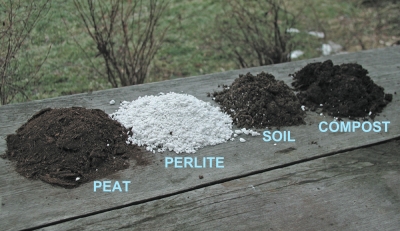
Why not just dig up some good garden soil? Because a flower pot or whatever container a plant is growing in unavoidably creates “perched water table” at its bottom. Garden soil, even good garden soil, is so dense that it will wick too much water up from that perched water table. Waterlogging is apt to result, and waterlogged soil lacks air, which roots need in order to function. (More about perched water tables and lots of other stuff about soil, propagation, plant stresses, and more can be found in my book The Ever Curious Gardener: Using a Little Natural Science for a Much Better Garden.)
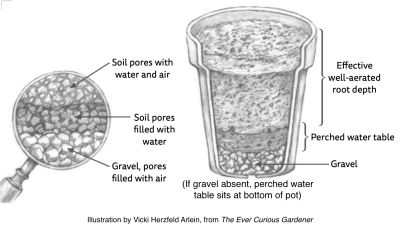
Coarse mineral aggregates — perlite, in my mix — make potting soils less dense, so water percolates more readily into the mix, through it, and out the bottom of the container. Other aggregates include vermiculite, sand, and calcined montmorillonite clay (aka kitty litter). I chose perlite because vermiculite breaks down with time and can contain asbestos. Sand is heavy, although this can be an effective counterbalance for top heavy cactii.
The peat moss and compost in my mix are organic materials that slurp up water like a sponge; plants can draw on this “water bank” between waterings. One peat to avoid is “peat humus,” a peat that is so decomposed that it has little water-holding capacity. Organic materials also buffers soil against drastic pH changes and cling to nutrients which are slowly re-released to plant roots. Otherwise these nutrients run out through the bottom of seedling flats and flower pots.
Peat is relatively devoid of nutrients but the compost provides a rich smorgasbord of nutrients. And I can brew it myself. Just letting piles of autumn leaves decompose for a couple of years produces “leaf mold,” which has roughly the same properties as compost.
Potting soils made with garden soil and compost might need to be pasteurized to eliminate pests especially weeds. Too much heat should be avoided, however, because toxins which injure plants will form and beneficial organisms will be eliminated. When I am going to pasteurize, I do so only to the garden soil in the mix; my composts get to above 150°F all on their own.
To pasteurize potting soil, put it in a baking pan, bury a potato in it, and bake it in a medium oven. When the potato is baked, the soil is ready. Pasteurization is not absolutely necessary; I pasteurize to kill weed seeds.
What You Buy Isn’t . . .
Go out and buy a potting mix and, in all likelihood, that mix will be devoid of any real garden soil. You can mix up a so-called “soil-less” potting mix by sieving together equal volumes of peat moss and perlite. Since the mix has no garden soil or compost to supply nutrients, add 1/2 cup of dolomitic limestone, 2 tablespoons of bone meal, and 1/2 cup of soybean meal to each bushel of final mix. This mix has enough fertility for about a month and a half of growth without additional fertilizer.
I favor traditional potting mixes, which contain real garden soil. Real soil adds a certain amount of bulk to the mix, as well as a slew of nutrients and microorganisms. Real soil provides buffering capacity, which allows for some wiggle room in soil acidity.
The Magic Happens
I wrote early on, “There is no magic to making potting soil.” I could toy with ratios and make a potting mix from perlite plus compost, perlite plus compost plus garden soil, even straight compost, depending on the texture of the compost.
Going forward, I’m going to experiment with coir and/or PitMoss, both possible substitutes for peat moss, the harvest of which is environmentally questionable.
For my first batch of potting mix for this season, I’ll stick with my usual recipe. Step one is to give the garage floor a clean sweep. 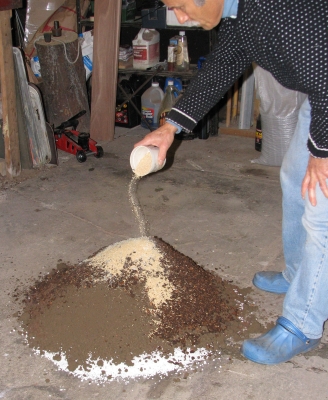 Then I pile up on the floor two gallons each of garden soil, peat moss, perlite, and compost. On top of the mound I sprinkle a cup of lime (except if I’ve sprinkled limestone on the compost piles as I build them), a half cup soybean, perhaps some kelp flakes.
Then I pile up on the floor two gallons each of garden soil, peat moss, perlite, and compost. On top of the mound I sprinkle a cup of lime (except if I’ve sprinkled limestone on the compost piles as I build them), a half cup soybean, perhaps some kelp flakes.
This is a mixed bag of ingredients, but I reason that plants, just as humans, benefit from a varied diet. I slide my garden shovel underneath the pile and turn it over, working around the perimeter, until the whole mass is thoroughly mixed.  I moisten it slightly if it seems dry. When all mixed, the potting soil gets rubbed through a 1/2″ sieve, 1/4” if it’s going to be home for seedlings.
I moisten it slightly if it seems dry. When all mixed, the potting soil gets rubbed through a 1/2″ sieve, 1/4” if it’s going to be home for seedlings.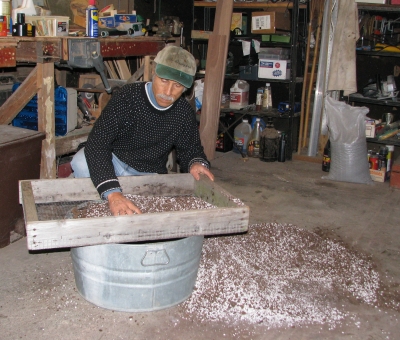
I end by clicking click my heels together three times and reciting a few incantations to complete this brew that has worked its magic on my seedlings, houseplants, and potted fruits each season.

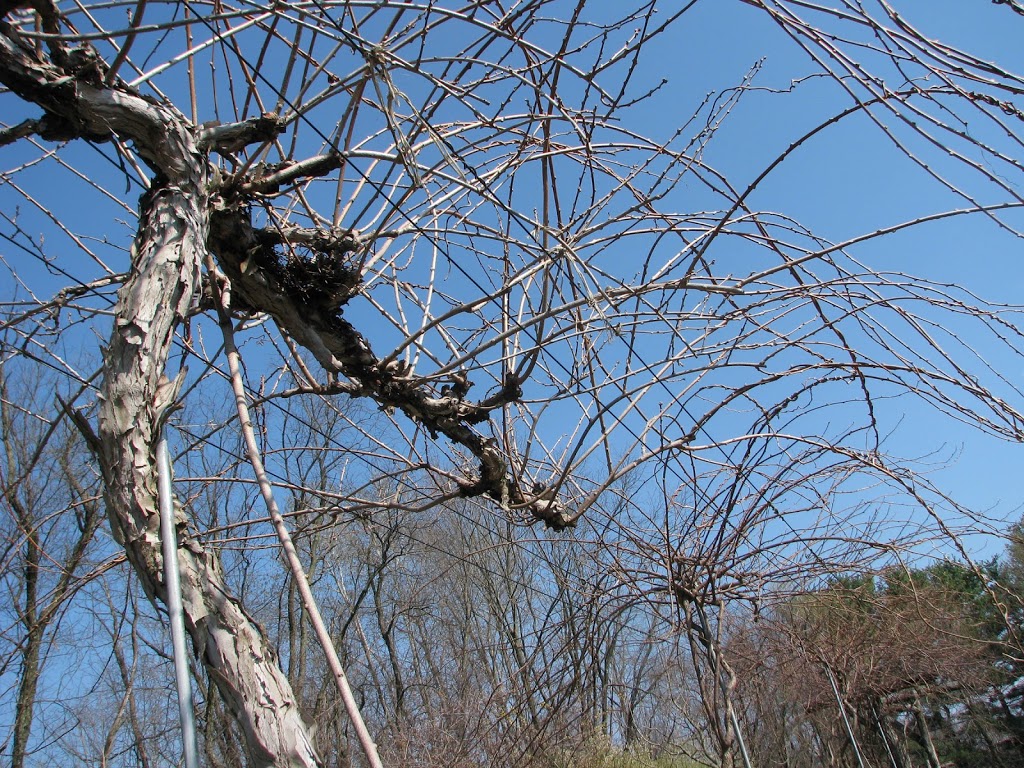
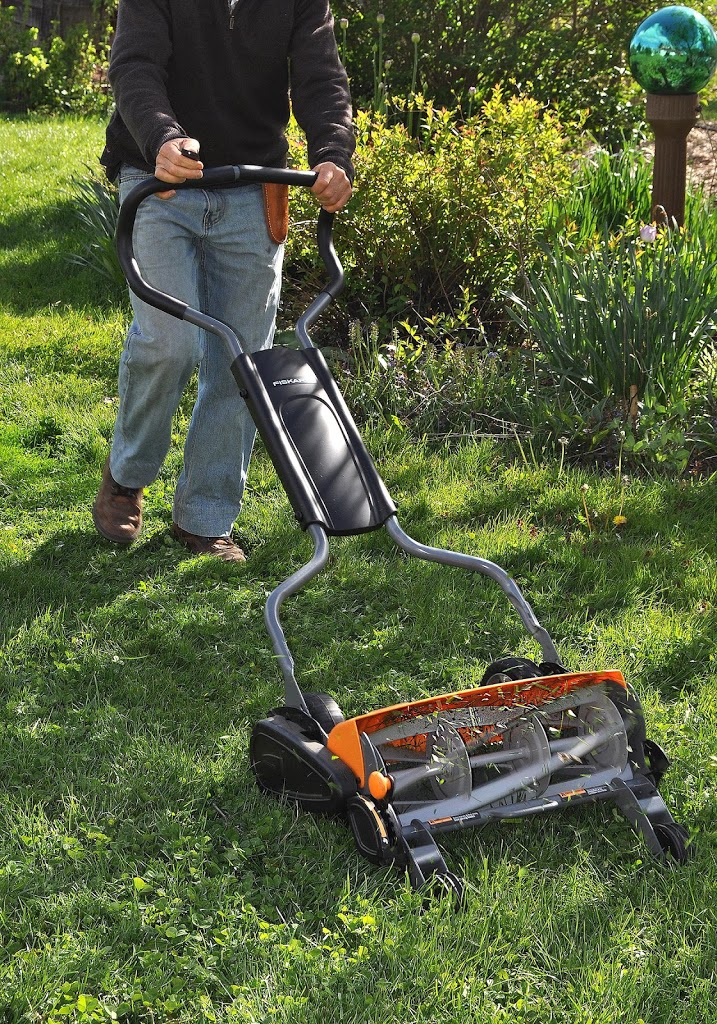
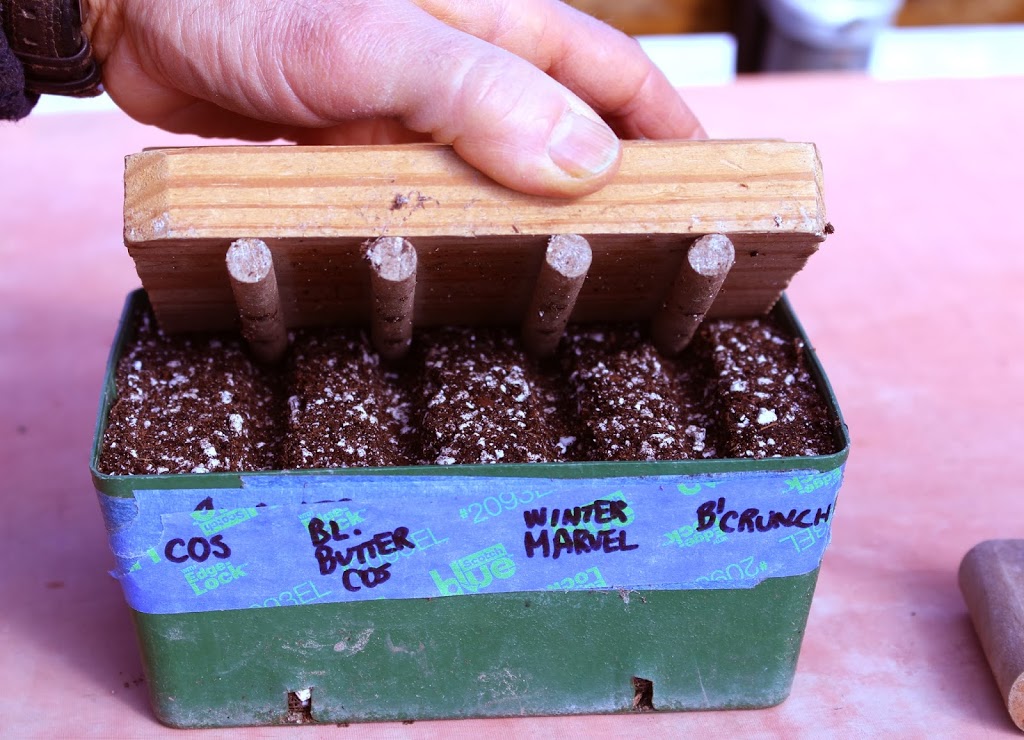
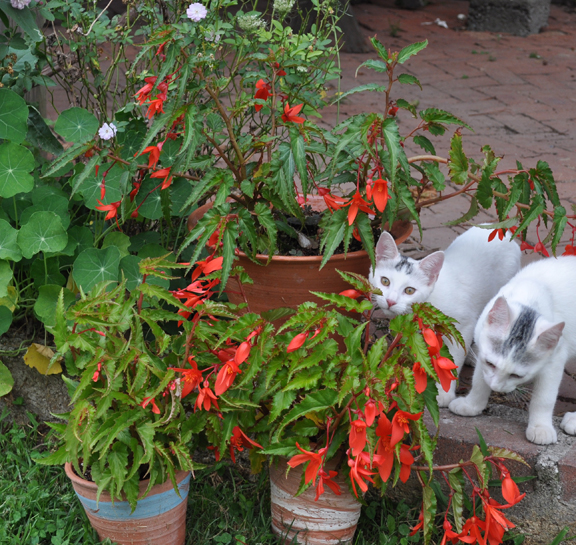

nice pics of the kitties!
Have tried any more environmentally sustainable alternatives to peat moss?
I tried coir once and was not happy with results. But I have to look into it more carefully. I’ll also be trying PitMoss. One more possibility is to just use my own compost.
What was the problem w coconut coir? Peat moss is the equivalent of old growth forest- hundreds if not thousands of years old and great at absorbing carbon dioxide.
The few times I tried using coir in my potting mixes, plants did not grow as well as with the peat. I have to try it again, though, more carefully.
Try it side by side with a commercial pro-mix and tell me the results. I believe there is a good reason that most commercial green house growers let Canadian companies produce the product they use in their operations. Mix in some Osmocote and results are difficult to beat with a home made mix.
I use a commercial pro-mix for my veg starts and make my own mix for my fruit tree nursery- my trees thrive in a heavier mix with compost as part of the equation- I don’t add garden soil or sand (just the perlite) because I try to keep the 25 gallon pots as light as possible and I start them in Whitcomb grow bags in real soil. So there is a core of real soil in the pots with good draining potting mix surrounding it. Surprised me how well that has worked.
Hi Alan, I have compared my mix with commercial mixes and it does just as well.
Ok, so vermiculite performs quite differently than perlite. I would not think of them as interchangeable. Vermiculite has excellent wicking characteristics which can overcome the hydrophobic properties of peat moss (if allowed to get bone dry). Vermiculite does not inherently contain asbestos. The stuff from Libby Montana was an issue many, many years ago. But there are plenty of other mines that are not contaminated. I would worry about the old stuff found in home insulation, not new horticultural bags. I’ve found that vermiculite holds up quite nicely. It has an excellent cation exchange capacity. And it’s a great source of silica which strengthens plant tissues.
Coir is nice because it readily absorbs water, even when bone dry. But you need to source stuff that is properly rinsed. And it needs to be buffered with Cal Mag.
I literally just made a small batch for some lettuce seedlings: 75% Coir / 20% Vermiculite / 5% Perlite + Plant-tone & Garden-tone.
I’m surprised you didn’t mention wood barks. Pine bark fines are excellent potting soil substrates. The lignin in the bark resists decomposition which reduces concerns over nitrogen draft. The rigid structure increases pore spacing and helps to reduce compaction.
I think N95s should be worn when mixing these materials, especially if indoors. And the process is so much easier when done on a tarp. Just fold over the corners and keep tossing the pile until mixed. That’s what I do when mixing large batches of wicking substrate for my self-watering planters.
There are many routes to the “mountaintop.” There’s no one best potting mix; a good mix can be made by choosing from a number of ingredients and adjusting their proportions accordingly. My mix doesn’t have enough peat that I need the extra wicking of vermiculite. My mix also has enough real soil and compost for good CEC. One of the main downsides, for me, to vermiculite is that it breaks down over time. I use the same mix for seedlings and for large potted plants that might fo a couple of years or more before being root pruned and repotted.
I’m going to try out pine bark fines, although I might also try out some mixes composed of only perlite, garden soil, and compost.
I’ll stick with my shovel mixing, though. It seems easier and more effective that your tarp turnning method.
I agree that there’s no single, ultimate solution. That’s for sure! I use different formulas for my seed starting mixes than my wicking boxes. I have a 4′ x 8′ sub-irrigated planter filled with 32 cu ft of wicking / potting mix. A tarp allowed me to easily mix the substrate on site and then transfer it to the bed. I do it in batches, piling it all up. Rake it a little with a bow rake. Flip the tarp corners and rake some more. Using light substrates, it’s easy, thorough & cleanup is quick.
The peat moss wicks just fine, unless it accidentally dries out. That’s when the vermiculite helps. I don’t use heavy, silty components in my wicking boxes, so no garden soil. Pore spacing is crucial, while also maintaining vertical capillary action 12 inches above the reservoir. But this has helped to maintain a long-lived fully functional outdoor wicking mix. Even after 11 years the substrate has performed well. The vermiculite particles have broken apart some, but I don’t see that as real detriment to the substrate.
Meowsers love those kitties!!! Thanks for the soil tip!
I am trying seed starting for the first time this season, and have one tray going with coir pellets and others with a home mix of peat, compost, and pearlite. All are on self watering capillary mats that seem to be working well. Many seed starting guides that start with commercial soil-less mixes suggest fertilizing a month or so in, but it isn’t obvious a) if my mix with compost also needs extra fertilizing (I assume the coir ones will) and b) how you apply fertilizer if using a capillary mat system.
Depending on the ripeness and amount of compost, seedlings with compost may or may not need fertilizer. To apply a fertilizer, use one that will dissolve in water and then water the seedlings from above so the solution percolates into the potting mix.
I guess it depends on where you live. A lot of peat moss comes from drained areas where the land is being claimed for other purposes. If the peat moss is not packed up and shipped to garden centres it would likely end up in land fills or just mixed into other substrates. Most people in North America live no where near where coir would be harvested. And then shipped, trucked and railed to where people would use it. I guess coir from underdeveloped countries could be used as a source of income for them. But why strip it away when they could just use it themselves? And this also encourages them to use un-environmental alternatives. It seems where you live it is unlikely coir is more sustainable then peat. I bought a brick of compressed coir once. It was supposed to be soaked in a bucket for 48 hours. After 10 days of soaking and some time hitting it with a hammer I had 4 or 5 chunks of coir bricks. I burried it the yard, it remained there unchanged for years. I was using a fair amount of peat moss until I clued in what granulated peat was, which is all I find in my area. The water retaining cells with in it have been chopped through. Leaving it as a simple light material incapable of retaining water. I still buy one big bag and use it mixed in with my mix in the buckets I grow tomatoes and peppers. I love reading your info. Thank you.
So I am very new to gardening but I would like to get better at it and make my own potting soil. I live in Arizona (zone 9a)… would this mix work in extremely hot temps?
Also where is the best place to find the base ingredients for the mix like peat and perlite, etc?
The mix should be fine in very hot temperatures. Any garden center or building supply place should have peat and perlite.